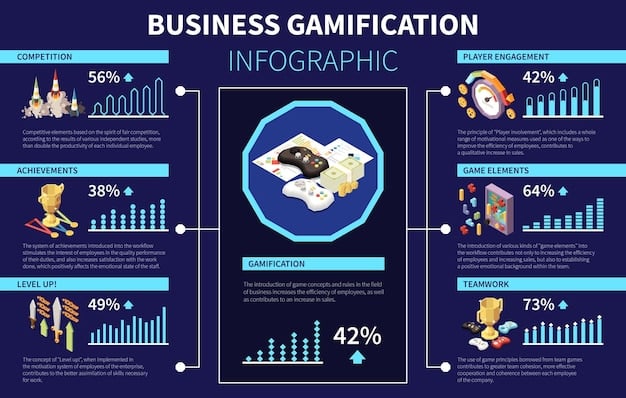US Esports Tournament Prize Pools: Top Payout Games in 2025

In 2025, the US esports landscape anticipates significant shifts in prize pool distributions, with games like Dota 2, League of Legends, and Counter-Strike traditionally dominating average payouts due to their established global competitive circuits and massive fan bases.
The landscape of competitive gaming is ever-evolving, and for aspiring professionals, understanding where the most significant financial opportunities lie is crucial. As we look towards 2025, a critical question emerges for players and fans alike: US Esports Tournament Prize Pools: Which Games Offer the Highest Average Payouts in 2025? This exploration goes beyond mere speculation, delving into the factors that shape these lucrative ecosystems and forecasting which titles are poised to offer the most substantial returns for top-tier talent in the United States.
The escalating stakes: understanding esports prize pools
Esports prize pools are the lifeblood of competitive gaming, directly incentivizing players and teams to dedicate countless hours to honing their skills. These financial rewards are what transform a passion into a viable career, attracting top talent and driving the narrative of high-stakes competition. The growth of these prize pools is a clear indicator of the overall health and expansion of the esports industry, reflecting increasing investment from publishers, sponsors, and viewers.
Historically, prize pools have grown exponentially, shattering records year after year. This upward trend is fueled by several factors: increased viewership, which attracts more advertising revenue; direct contributions from game developers and publishers committed to fostering a vibrant competitive scene; and innovative crowdfunding models, where a portion of in-game purchases directly contributes to a tournament’s prize pool. These combined efforts create a self-sustaining cycle of growth, where success on the competitive stage translates into more funding for future events.
The dynamics of prize pool distribution
The structure of prize pools can vary significantly from one game to another. Some titles feature “winner-take-all” scenarios, concentrating wealth at the very top, while others distribute funds more broadly across multiple teams, offering a more sustainable living for a larger contingent of professional players. Understanding these distribution models is key to assessing the real financial viability of competing in any given game. Furthermore, the number and frequency of tournaments also play a pivotal role. A game with fewer, very large tournaments might skew average payout figures, whereas a game with a consistent stream of smaller, but still substantial events, might offer more stable earnings over time.
Impact of crowdfunding on prize pools
Crowdfunding has revolutionized esports prize pools, particularly for games like Dota 2, which pioneered and perfected the model with its annual “The International” championship. By allowing passionate fans to directly contribute through in-game purchases, the prize pools swell to astronomical figures, often reaching tens of millions of dollars. This not only engages the community but also creates a direct link between fan support and player earnings, strengthening the ecosystem. For 2025, it’s anticipated that more game titles will embrace or further refine their crowdfunding strategies, recognizing its immense potential to elevate competitive rewards and deepen fan engagement.
Key contenders: games with historical high payouts
When discussing high payouts in esports, certain games consistently emerge at the forefront. These titles have cultivated robust competitive ecosystems over many years, supported by massive player bases, dedicated developers, and significant investment. Their large prize pools are not just a reflection of their popularity but also of their ability to maintain a compelling competitive integrity and attract global audiences. Looking back at historical data provides a solid foundation for predicting future trends, identifying which games have the infrastructure and momentum to continue leading the pack in 2025.
The sheer scale of these established titles means they command the lion’s share of attention and financial backing. Their annual marquee events are often the most watched and most rewarding, creating aspirational goals for countless players worldwide. The consistency of their presence at the top of the prize pool rankings speaks volumes about their enduring appeal and the strategic foresight of their respective publishers in building sustainable competitive circuits.
Dota 2: the prize pool behemoth
For years, Dota 2 has been synonymous with the largest prize pools in esports history, primarily due to “The International,” its annual world championship. This event consistently sets new records, with its prize pool heavily augmented by a crowdfunding model involving in-game Battle Pass sales. Players contribute directly to the competitive scene, demonstrating a unique synergy between the community and professional play. As we approach 2025, Dota 2 maintains a strong position, and while individual tournament payouts might fluctuate, its average per-player earning potential remains exceptionally high for top-tier competitors.
- Unrivaled Crowdfunding: The Battle Pass system continues to fuel monumental prize pools for The International.
- Global Reach: A massive international player base ensures continued interest and investment.
- Established Legacy: Decades of competitive history foster a deep-rooted and passionate community.
League of Legends: consistent ecosystem
While League of Legends might not always boast the single largest tournament prize pool like Dota 2, its overall competitive ecosystem is arguably the most robust and consistent. Riot Games, the developer, invests heavily in its regional leagues and the annual World Championship, ensuring a steady stream of high-stakes tournaments. This distributed model means that more professional players across a wider range of teams can earn a sustainable living. For 2025, League of Legends is expected to continue its trend of substantial, consistent payouts, offering numerous opportunities for players within its well-structured professional circuits across the US and globally.
Riot’s commitment to creating franchised leagues has further stabilized the financial aspect for many professional organizations and players. This structure provides a clearer path to sustainable income beyond individual tournament wins, incorporating salaries and other benefits that contribute to a more professionalized environment. The sheer volume of high-level tournaments throughout the year ensures continuous competitive activity and, by extension, continuous earning potential for those at the top of their game within the US and international circuits.

Emerging titans and dark horses for 2025
Beyond the established giants, the esports landscape is constantly evolving, with new titles and revamped strategies from existing ones challenging the status quo. Predicting which games will offer the highest average payouts in 2025 requires looking beyond current trends to identify titles with significant growth potential, strong developer support, and burgeoning competitive scenes. These “emerging titans” or “dark horses” could surprise many, reshaping the top echelons of esports earnings.
Innovation in game design, accessibility for new players, and strategic marketing by publishers can all contribute to a game’s sudden surge in popularity and, consequently, its competitive investment. A strong grassroots community, coupled with a clear pathway to professional play, can nurture the talent necessary to sustain a high-level competitive scene worthy of substantial prize pools. It’s not just about launch hype; it’s about building a foundation that can truly last and attract long-term financial commitments.
Valorant: rapid ascent and sustained growth
Riot Games’ tactical shooter, Valorant, has experienced a meteoric rise in the esports scene since its launch. Backed by Riot’s extensive experience with League of Legends, Valorant boasts a franchised league system, significant developer investment, and a rapidly expanding global player base. Its competitive structure is designed for long-term sustainability, ensuring consistent high-level play and attractive prize pools. For 2025, Valorant is poised to be a top contender for average payout figures, particularly as its global circuit “VCT” (Valorant Champions Tour) matures and global viewership continues to climb, attracting more sponsors and larger events, including those in the US.
- Strategic Franchising: The VCT league system provides stability and consistent earnings.
- Publisher Backing: Strong financial and organizational support from Riot Games.
- Growing Viewership: Rapidly increasing popularity means more revenue and larger prize pools.
Counter-Strike 2: revitalized competitive scene
With the transition from CS:GO to Counter-Strike 2, Valve’s iconic first-person shooter franchise has received a significant overhaul, breathing new life into its already legendary competitive scene. Counter-Strike has always been a staple of esports, known for its deep tactical gameplay and dedicated fan base. The update to CS2 is expected to rejuvenate its appeal, potentially leading to increased viewership numbers and, consequently, larger prize pools as sponsors flock to the revitalized title. In 2025, Counter-Strike 2 tournaments, including the prestigious Majors, are expected to offer highly competitive average payouts, solidifying its position among the top earners in the US landscape.
The inherent competitive depth of Counter-Strike has always attracted dedicated players and viewers. The strategic nuances, high skill ceiling, and ever-present possibility of clutch plays make it endlessly entertaining. The shift to CS2, with its graphical enhancements and technical improvements, has invigorated this core appeal, promising to retain its loyal community while also drawing in new fans. This renewed interest translates directly into a more valuable competitive product, enticing more significant investment from tournament organizers and brands, thereby boosting prize contributions.
Factors influencing average payouts in the US market
The United States plays a pivotal role in the global esports ecosystem, boasting a robust infrastructure, a massive audience, and significant investment capital. However, the factors that elevate average payouts in the US market are multifaceted, extending beyond just game popularity. Understanding these nuances is crucial for players aiming to maximize their earnings and for fans seeking insight into the economic forces driving their favorite competitive scenes.
The maturity of the US esports market allows for sophisticated business models, including team franchising, media rights deals, and dedicated esports arenas, all of which contribute to a more professionalized and financially lucrative environment. The strong presence of major technology and entertainment companies in the US further amplifies investment, distinguishing it from many other regions.
Sponsorship and brand investment
A significant portion of large prize pools stems from corporate sponsorships. Major brands, eyeing the lucrative demographic of esports fans, invest heavily in tournaments, teams, and individual players. The US market, with its strong economy and consumer base, is particularly attractive for these brands, leading to substantial endorsement deals and direct contributions to tournament prize money. In 2025, robust brand partnerships, particularly with non-endemic brands seeking to enter the esports space, will likely continue to be a primary driver of high average payouts across various titles.
Franchised leagues and structured ecosystems
The proliferation of franchised leagues in the US, such as the League of Legends Championship Series (LCS) and the Call of Duty League (CDL), has introduced a level of financial stability previously unseen in esports. These leagues offer guaranteed salaries to players, revenue sharing models for teams, and consistent competitive schedules, which collectively contribute to higher average earnings. This structured approach contrasts sharply with the more open circuit models of some other games, providing a more reliable income stream for a wider pool of professional players. In 2025, the continued expansion and refinement of these franchised models are expected to solidify their impact on player earnings.
The appeal of franchised leagues is manifold: they provide a sense of long-term security for investors, teams, and players. Teams operate with defined spots in a league, reducing the volatility of qualification and allowing for better long-term planning. For players, this means stable salaries and benefits, enabling them to focus purely on their performance without constant financial anxieties. This professionalization of the industry, particularly prominent in the US, naturally leads to higher overall earnings, as more corporate structures mean greater financial backing and better revenue generation through media rights and sponsorship deals.
Beyond the giants: emerging trends and niche growth
While mainstream esports titles often dominate the headlines with their massive prize pools, the dynamic nature of the industry means that opportunities can emerge from unexpected corners. Beyond the established giants, a closer look reveals a landscape ripe with niche games gaining traction and novel competitive formats attracting new player bases and investment. These emerging trends and niche growth areas, while perhaps not reaching the astronomical figures of a “The International,” are crucial for the overall health and diversity of the esports ecosystem, potentially offering specialized high average payouts in 2025 for those who carve out a path in them.
The rapid evolution of gaming technology and player preferences ensures that the competitive scene is never static. New genres, innovative gameplay mechanics, and independent game development can all contribute to the rise of unexpected esports contenders. Identifying these earlier stages of growth allows for a more comprehensive understanding of the potential future earning landscape.
Fighting games: consistent and dedicated communities
The fighting game community (FGC) often operates on a different model than the larger, team-based esports. While individual tournament prize pools might be smaller, the sheer volume of events, often community-driven, provides consistent earning opportunities for top players. Titles like Street Fighter, Tekken, and Mortal Kombat maintain incredibly dedicated fan bases and highly skilled competitors. With new iterations anticipated and continued developer support, the FGC might see an increase in average payouts in 2025, especially as more mainstream tournaments integrate these competitive staples, bringing larger crowds and more prize money.
- Dedicated Fan Base: A long-standing and passionate community ensures consistent competitive activity.
- Frequent Tournaments: Numerous local and regional events offer regular earning potential.
- Individual Skill Focus: High individual skill ceiling appeals to competitive players seeking direct impact.
Mobile esports: exponential global growth
Mobile gaming has exploded globally, and its competitive counterpart, mobile esports, is following suit at an unprecedented pace. Games like Mobile Legends: Bang Bang, Free Fire, and PUBG Mobile are massively popular, especially in Asian markets, but their growth in the US is undeniable. As infrastructure improves and competitive circuits mature in North America, the prize pools for mobile esports titles are set to see significant increases. For 2025, mobile esports could emerge as a dark horse for average payouts, offering substantial opportunities for players who can dominate on smaller screens.
The accessibility of mobile gaming is a key driver of its competitive growth. With hundreds of millions of players worldwide, the potential audience for mobile esports is enormous. This vast reach translates into significant advertising revenue and sponsorship opportunities, which in turn fuel larger prize pools. As mobile devices become more powerful and dedicated esports hardware for mobile becomes more prevalent, the competitive landscape will only become richer and more financially rewarding, particularly in markets like the US where mobile penetration is incredibly high.
Methodology and predictive modeling for 2025 payouts
Accurately forecasting esports prize pools for 2025 is a complex endeavor that goes beyond simple trend extrapolation. It requires a sophisticated approach, integrating historical data analysis with an understanding of economic indicators, industry trends, and specific game developer strategies. Our predictive modeling considers several tiers of influence, from global economic forecasts to micro-level game community engagement, to provide a nuanced outlook on which titles are poised to offer the highest average payouts in the US market.
The methodologies employed balance quantitative analysis of past prize money with qualitative assessments of game developer commitment, community sentiment, and the overall growth trajectory of specific esports titles. This holistic perspective allows for a more resilient forecast, adapting to the dynamic nature of the competitive gaming industry.
Data analysis: historical performance and growth rates
The primary input for our predictions is extensive historical data on tournament prize pools for major esports titles. By analyzing past tournament data, including total prize money distributed, the number of events, and the average payout per player or team, we can identify historical growth rates and sustainable trends. Games that have consistently shown year-over-year increases in prize distribution are more likely to continue this trajectory into 2025. This historical perspective allows us to weight established titles more heavily, given their proven track record within the competitive ecosystem.
Economic indicators and industry trends
Beyond individual game metrics, broader economic indicators and industry trends play a crucial role. Factors such as global economic stability, the growth of the entertainment sector, and the increasing mainstream acceptance of esports can influence overall investment levels. We also consider specific esports industry trends like the expansion of franchised leagues, the evolution of viewership platforms, and the influx of new non-endemic sponsors. These macro-level influences can significantly impact the overall financial health of the esports industry and, consequently, the size of future prize pools across the US market.
The increasing professionalization of esports organizations and support staff also contributes to a more stable financial environment. As teams become more structured and business-savvy, they are better equipped to attract larger sponsorships and optimize their revenue streams, ultimately benefiting players through more competitive salaries and prize money. This shift from ad-hoc operations to corporate entities is a significant trend that underpins the forecasted growth in average payouts.
The long game: sustainability and player welfare
While chasing the highest average payouts is a natural pursuit for professional esports players, the conversation around prize pools must also encompass the broader themes of sustainability and player welfare. A healthy esports ecosystem isn’t solely defined by astronomical payouts at the very top, but by the ability for a broader segment of professional players to forge stable, long-term careers. The emphasis for 2025 and beyond will increasingly shift towards creating environments where players can thrive, both financially and personally, ensuring the longevity of their careers and the integrity of the competitive scene.
This holistic view includes considerations like health benefits, mental health support, comprehensive retirement planning, and robust players’ associations. Such measures are crucial for professionalizing the industry further and attracting even more dedicated talent, knowing their long-term well-being is considered. The pursuit of prize money should not come at the cost of player burnout or exploitation, and the industry is collectively moving towards more protective frameworks.
Career longevity and player support systems
The intense nature of professional esports often leads to short career spans. High average payouts at peak performance are vital, but so are systems that support players throughout their careers, from talent development to retirement. Organizations and publishers are increasingly investing in player welfare, offering coaching, sports psychology, and financial planning services. These initiatives, while not directly contributing to prize pools, create a more sustainable environment where players can maximize their earning potential over a longer period, making the industry more attractive as a long-term career path.
The role of unions and player associations
As esports matures, player unions and associations are becoming more prevalent, advocating for fair wages, safe working conditions, and equitable prize pool distribution. These bodies play a crucial role in ensuring that players receive their fair share of the burgeoning industry revenue, not just from tournament winnings but also from merchandise, streaming, and media rights. In 2025, the increased influence of these associations is expected to positively impact average payouts and overall player benefits, forcing a more transparent and player-centric approach from tournament organizers and game publishers. Their collective bargaining power ensures that the economic growth of esports is shared more equitably with the talent that drives it.

| Key Aspect | Brief Insight for 2025 |
|---|---|
| 🏆 Top Games | Dota 2, LoL, CS2, Valorant expected to lead in payouts. |
| 💰 Funding Sources | Crowdfunding, sponsorships, and media rights are key drivers. |
| 📈 US Market Edge | Strong economy, established leagues, and brand investment boost payouts. |
| 📱 Mobile Esports | Significant growth potential, especially in North American markets. |
Frequently Asked Questions
▼
Dota 2 and League of Legends are consistently projected to lead in average payouts due to their well-established global circuits and ongoing significant investment from their respective developers, Valve and Riot Games. Valorant and the revitalized Counter-Strike 2 are also strong contenders for top positions in terms of average earnings.
▼
Esports prize pools are primarily funded through a combination of sources: direct contributions from game publishers, revenue generated from corporate sponsorships and advertising, and increasingly, through crowdfunding initiatives where a portion of in-game purchases directly adds to the prize money for major tournaments.
▼
Yes, franchised leagues significantly impact player payouts by providing stable salaries, benefits, and potentially revenue sharing, regardless of individual tournament performance. This structure offers a more consistent and predictable income stream for professional players compared to traditional open circuits, thus increasing their average earnings.
▼
Viewership plays a crucial role as it directly influences sponsorship and advertising revenue, which are major components of prize pools. Games with higher viewership attract more brands and larger financial commitments, leading to increased prize money. This creates a positive feedback loop: more viewers attract more money, which attracts more talent and competition.
▼
Mobile esports are rapidly growing globally, and their impact on prize pools in the US is becoming more significant. While historically smaller than PC counterparts, the increasing player base and investment in mobile titles mean that games like Mobile Legends and PUBG Mobile are projected to offer substantial and growing average payouts in 2025 and beyond.
Conclusion
As we navigate the competitive esports landscape of 2025, it’s evident that while traditional titans like Dota 2, League of Legends, Counter-Strike 2, and the rapidly ascending Valorant are poised to offer the highest average payouts in the US, the ecosystem is far more dynamic than it appears. The interplay of sustained developer investment, innovative crowdfunding, robust sponsorship, and increasingly professionalized league structures all contribute to the burgeoning financial opportunities available to top-tier players. Beyond the raw numbers, the industry is maturing, with a growing emphasis on player welfare and career sustainability, ensuring that the pursuit of high payouts is part of a healthier, more enduring professional path for competitive gamers. The future of US esports payouts is not just about big numbers, but about a vibrant, diverse, and well-supported competitive scene.





